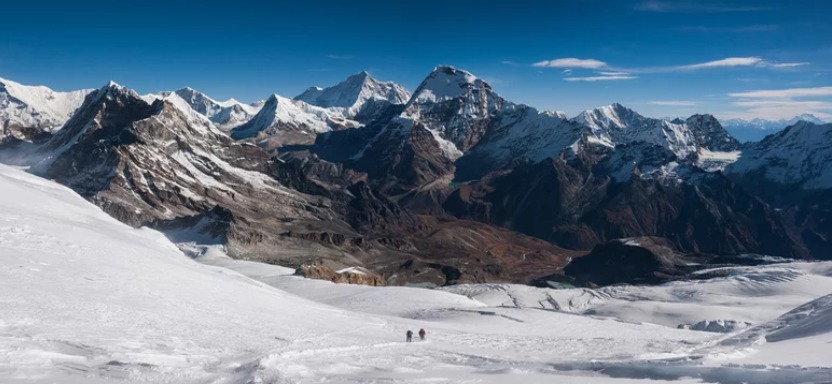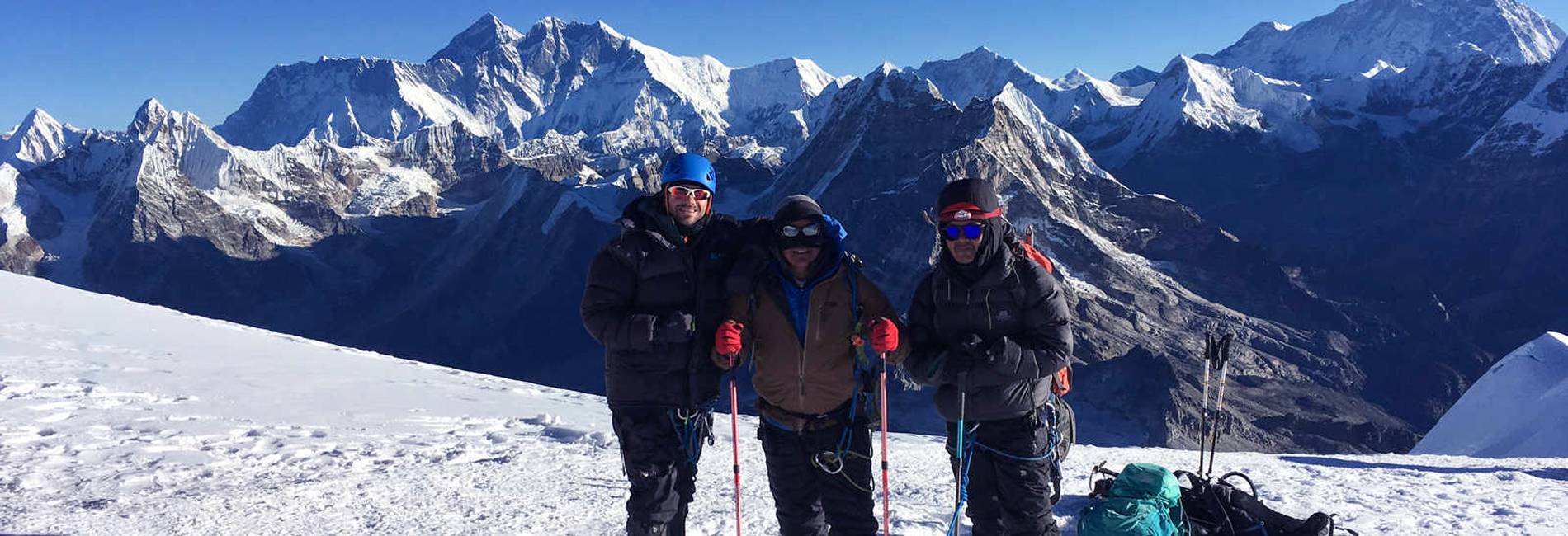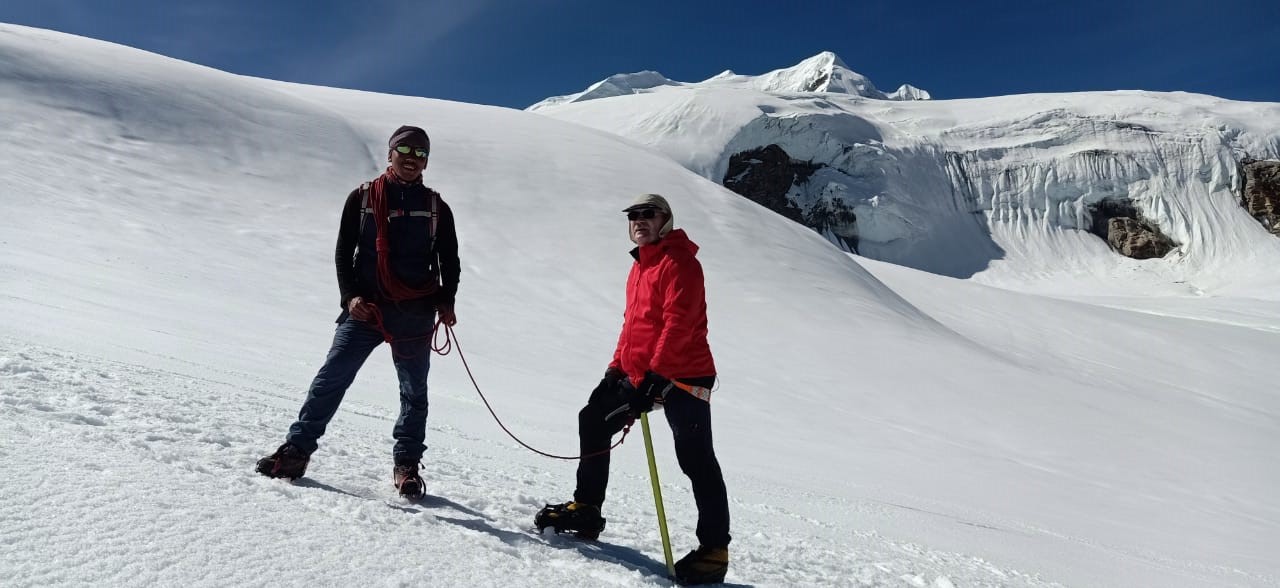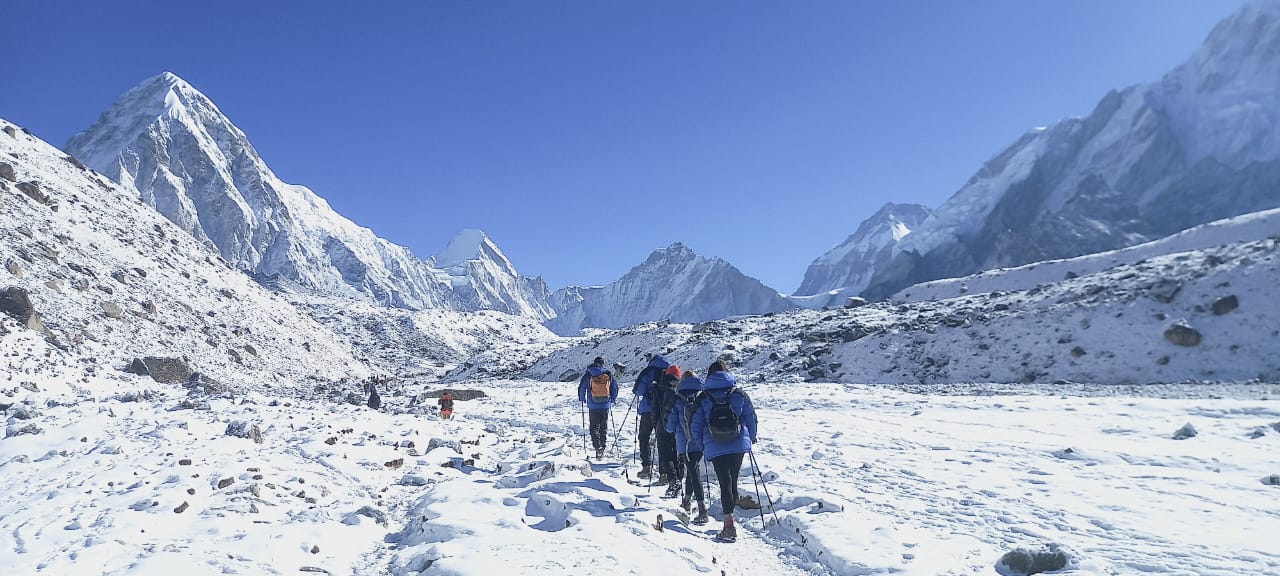26th August, 2025

Jan 31, 2024
Mera Peak Climbing in September
- Why Mera Peak Climbing in September
- How is the Weather to Climb Mera Peak In September
- Weather, Climate, and Temperature In Mera Peak
- How Difficult to Climb Mera Peak In September
- Lukla Flight in September
- What should I pack for Mera Peak Climbing
- Can I Hire Climbing Equipment from Khare
- What is the Success Rate of Mera Peak Climbing
- How Technical is Mera Peak Climbing
- Which Route is Best for Mera Peak Climbing
- Useful Tips for Mera Peak in September
- What About the Accommodation?
- Mera Peak Climbing Permit
- How are the High-Altitude Weather Conditions?
- Conclusion
- Mera Peak Climbing Packages
Mera Peak, standing at 6,476 meters (21,247 feet), is Nepal's highest trekking peak and a popular destination for climbers seeking to summit a Himalayan peak without the technical demands of higher mountains. Climbing Mera Peak in September offers a unique adventure amidst the breathtaking landscapes of the Khumbu region.
September marks the end of the monsoon season in Nepal, making it an ideal time for Mera Peak climbing. The weather begins to stabilize after the rains, with clear skies and stunning visibility allowing for panoramic views of nearby giants like Everest, Lhotse, and Makalu. The lush landscapes rejuvenate with greenery, adding to the beauty of the trekking route.
The climb itself typically begins with a scenic flight from Kathmandu to Lukla, followed by a trek through picturesque Sherpa villages like Namche Bazaar and Pangboche. These villages provide opportunities to acclimatize and immerse oneself in local culture before ascending towards Mera Peak.

MERA PEAK SUMMIT 10 DAYS
This is a chance to go climbing without the necessary permits that most climbing expeditions require in Nepal. Mera Peak fits the bill perfectly and at (6,476m/21,190ft) you will have spectacular view...
Climbing Mera Peak does not require extensive mountaineering experience, but basic trekking and glacier travel skills are essential. The ascent involves navigating through rocky trails, crossing crevassed glaciers, and ascending snow slopes to reach the summit. A high camp is usually established at around 5,800 meters (19,029 feet) to prepare for the final push to the peak.
September offers moderate temperatures during the day, ideal for climbing, although nights can be chilly at higher altitudes. Proper gear, including insulated clothing, crampons, and a sturdy tent, is necessary for comfort and safety during the climb.
The summit day typically starts early to take advantage of stable weather conditions and clear skies. From the summit of Mera Peak, climbers are rewarded with unparalleled views stretching across the Himalayas, making the challenging ascent well worth the effort.
Overall, climbing Mera Peak in September combines the thrill of high-altitude adventure with the beauty of Nepal's post-monsoon landscapes, promising an unforgettable experience for mountaineers and trekkers alike.
Why Mera Peak Climbing in September
September is an excellent time for Mera Peak climbing due to favorable weather conditions following the monsoon season. The monsoon rains have cleared, leaving the landscapes lush and green, with pristine views of the Himalayas. The skies are generally clear, offering optimal visibility for climbers to enjoy breathtaking panoramas of Everest, Lhotse, and Makalu from the summit. The moderate temperatures during the day make trekking and climbing comfortable, while cooler nights at higher altitudes are manageable with proper gear. September also sees fewer climbers compared to peak seasons, providing a more serene and less crowded experience on the mountain.

MERA PEAK CLIMBING
Mera Peak Climbing is an exhilarating adventure in Nepal that gives you an opportunity to reach the summit of Mera Peak at more than 6400m above sea level. Actually, it is the highest climbing (w...
How is the Weather to Climb Mera Peak In September
The weather in September is typically stable and clear, making it an ideal time for climbing Mera Peak. As the monsoon season ends, the skies gradually clear up, reducing the chances of rainfall and snowfall. Daytime temperatures at lower elevations are pleasant, ranging from mild to warm, while temperatures at higher altitudes remain cool. Climbers can expect mostly dry conditions, although occasional showers or clouds may still occur, particularly in the early part of the month. Proper acclimatization and preparation for varying weather conditions, including cold nights and potential snowfall at higher camps, are crucial for a successful ascent.
Weather, Climate, and Temperature In Mera Peak
Mera Peak, located in the Khumbu region of Nepal, experiences a varied climate depending on the altitude. In September, the weather is transitional as the region emerges from the monsoon season. Lower elevations, such as Lukla and Namche Bazaar, enjoy mild to warm temperatures during the day, averaging around 20-25°C (68-77°F). At higher altitudes, temperatures gradually decrease with altitude gain, ranging from 0°C to -10°C (32°F to 14°F) at Mera Peak Base Camp and High Camps. Nighttime temperatures can drop significantly, reaching below freezing, especially at the summit and high camps. Clear skies during the day provide excellent visibility for trekking and climbing, offering stunning views of snow-capped peaks and pristine landscapes. Climbers should prepare for a wide range of temperatures and weather conditions, including potential snowfall and wind, particularly at higher elevations.

MERA PEAK EXPEDITION 14 DAYS
The Mera Peak Expedition is a 14-day trek that offers a unique and challenging route to the summit of Mera Peak. The Upper Route is a less-traveled path that takes you through some of the most remote...
How Difficult to Climb Mera Peak In September
Climbing Mera Peak in September presents moderate to challenging conditions depending on individual fitness and experience levels. The ascent involves trekking through varied terrain, including rocky paths, moraines, and glaciers, which may be icy or crevassed. While technical climbing skills are not required, basic mountaineering experience and proficiency in using crampons, ice axes, and ropes are essential for navigating the glacier and ascending snow slopes. The altitude gain is significant, with Mera Peak standing at 6,476 meters (21,247 feet), requiring proper acclimatization and physical fitness. September offers favorable conditions with stable weather and clear skies, but climbers should be prepared for cold temperatures, potential snowfall, and the physical demands of high-altitude trekking. Overall, Mera Peak in September provides a challenging yet rewarding adventure amidst stunning Himalayan landscapes.
Lukla Flight in September
Flying into Lukla in September can be both exhilarating and challenging. As the monsoon season transitions into clearer weather, flights are generally more reliable compared to earlier months. However, weather conditions in the mountains can still be unpredictable, leading to occasional delays or cancellations due to fog or low visibility in the early mornings. It's advisable to schedule flights early in the day to increase the chances of departing on time. Be prepared for potential delays and remain flexible with your travel plans. The flight itself offers stunning aerial views of the Himalayas, including Everest, weather permitting, adding to the adventure of your journey to Mera Peak.
What should I pack for Mera Peak Climbing
Packing for Mera Peak climbing in September requires careful consideration of both clothing and equipment to ensure comfort, safety, and efficiency during the trek and ascent. Essential clothing includes moisture-wicking base layers, insulated mid-layers, a windproof and waterproof jacket, and sturdy trekking pants. Pack enough warm socks, gloves, and a hat to protect against the cold, especially at higher altitudes where temperatures can drop below freezing. Proper footwear with good ankle support and crampon-compatible soles is essential for navigating icy terrain. Other necessary gear includes a sleeping bag rated for cold temperatures, a headlamp with extra batteries, trekking poles for stability on uneven terrain, and a backpack to carry essentials during the day. Don't forget sun protection such as sunglasses, sunscreen, and a wide-brimmed hat to shield against strong UV rays at high altitudes. Lastly, pack personal items such as toiletries, a first-aid kit, and any medications you may need, ensuring your pack remains lightweight and manageable for the trek.
Can I Hire Climbing Equipment from Khare
Yes, it's possible to rent climbing equipment from Khare, a village situated at around 5,100 meters (16,732 feet) elevation and commonly used as a base camp for Mera Peak climbers. Local lodges and trekking agencies offer a range of climbing gear for rent, including crampons, ice axes, harnesses, helmets, and trekking poles. Renting equipment in Khare can be convenient for climbers who prefer not to carry bulky gear from Kathmandu or who may need additional items at higher altitudes. It's advisable to check the condition of rented equipment and ensure it meets safety standards before embarking on the ascent.

MERA PEAK EXPEDITION 13 DAYS
Mera Peak is one of the most popular and highest trekking peaks in Nepal, standing at 6,476 meters. The Mera Peak expedition is a 13-day trek that takes you through some of the most breathtaking scene...
What is the Success Rate of Mera Peak Climbing
The success rate of Mera Peak climbing varies depending on weather conditions, individual acclimatization, and the expertise of climbers and guides. Generally, Mera Peak has a high success rate compared to other Himalayan peaks of similar elevation due to its non-technical nature and gradual ascent profile. Most climbers who are properly acclimatized and well-prepared reach the summit successfully. Success rates are typically higher during the post-monsoon season (September-November) and pre-monsoon season (March-May) when weather conditions are stable and visibility is clear. Proper planning, acclimatization schedule, and having experienced guides contribute significantly to achieving a successful summit of Mera Peak.
How Technical is Mera Peak Climbing
Mera Peak climbing is considered non-technical in terms of technical mountaineering skills required. The standard route to the summit involves trekking through varied terrain including trails, moraines, and glaciers. The final ascent to the summit from the high camp includes walking on a gradual snow slope and may involve the use of crampons for traction and ice axes for stability. Basic mountaineering skills such as walking in crampons, self-arrest, and rope handling are essential, but prior technical climbing experience is not mandatory. However, climbers should be physically fit, accustomed to high-altitude trekking, and prepared for challenging conditions including cold temperatures, potential snowfall, and high altitude. Experienced guides provide instruction and support throughout the ascent, ensuring climbers can safely navigate the route and achieve a successful summit of Mera Peak.

MERA PEAK CLIMBING 17 DAYS
This is an excellent opportunity to climb Nepal’s highest peak without having to obtain a permit (6,476m/21,190ft). From the summit, you will have stunning views of several 8000m plus peaks, such as E...
Which Route is Best for Mera Peak Climbing
The most commonly used and recommended route for Mera Peak climbing is the standard route via the Mera La Pass. This route starts with a trek from Lukla through picturesque Sherpa villages like Namche Bazaar and Khare. From Khare, climbers ascend to Mera Base Camp, continue to High Camp, and then make the final push to the summit. This route offers a gradual ascent profile, allowing for proper acclimatization and stunning views of the surrounding Himalayan peaks throughout the journey.
Useful Tips for Mera Peak in September
- Weather Awareness: September marks the end of the monsoon season, so be prepared for changing weather conditions and occasional rain or snow showers.
- Physical Preparation: Train adequately beforehand with a focus on cardiovascular endurance, strength training, and altitude simulation exercises.
- Gear Checklist: Ensure you have all necessary climbing gear, including layers for cold weather, waterproof clothing, and sturdy trekking boots.
- Acclimatization: Take it slow to acclimatize properly, with planned rest days to avoid altitude sickness.
- Hydration and Nutrition: Stay hydrated and eat a balanced diet to maintain energy levels during the trek.
What About the Accommodation?
Accommodation during Mera Peak climbing typically consists of basic teahouses and lodges along the trekking route. In larger villages like Namche Bazaar and Lukla, more comfortable lodges with amenities such as hot showers and WiFi are available. At higher altitudes and closer to Mera Peak, accommodation is more basic, with dormitory-style rooms and shared facilities. It's advisable to book accommodation in advance during peak trekking seasons to ensure availability, although flexibility may be required due to weather and trekking conditions.

MERA PEAK CLIMBING 15 DAYS
The Mera Peak Expedition is a 15-day trek that takes you through some of the most stunning landscapes and challenging trails in Nepal. Mera Peak is the highest trekking peak in Nepal, standing at 6,47...
Mera Peak Climbing Permit
To climb Mera Peak, climbers require two permits: the Sagarmatha National Park Entry Permit and the Makalu Barun National Park Entry Permit. These permits can be obtained through authorized trekking agencies in Kathmandu or upon arrival at the respective park entry gates. Permits are necessary to ensure conservation efforts and safety regulations in the protected areas surrounding Mera Peak.
How are the High-Altitude Weather Conditions?
High-altitude weather conditions around Mera Peak in September are generally favorable after the monsoon season. Days are typically clear with mild temperatures, making trekking and climbing enjoyable. However, temperatures can drop significantly at night and at higher elevations, reaching below freezing. Be prepared for cold weather and potential snowfall, especially at Mera Peak Base Camp and High Camp. Proper clothing, gear, and acclimatization are essential for coping with high-altitude weather conditions and ensuring a safe and successful ascent.

Mera Peak Climbing 20 Days
This is a chance to go climbing without the necessary permits that most climbing expeditions require in Nepal. Mera Peak fits the bill perfectly and at (6,476m/21,190ft) you will have spectacular view...
Conclusion
Climbing Mera Peak in September offers a rewarding adventure amidst Nepal's stunning Himalayan landscapes. With favorable weather conditions, clear skies, and fewer crowds compared to peak seasons, September provides an ideal opportunity for climbers to summit this iconic peak. Proper preparation, including physical training, gear readiness, and acclimatization, ensures a safe and memorable experience. Embrace the challenge, soak in the breathtaking views, and enjoy the journey to the summit of Mera Peak, a pinnacle of adventure in the heart of the Himalayas.
Mera Peak Climbing Packages
Mera Peak Summit Return By Helicopter

MERA AND ISLAND PEAK CLIMBING
Embark on a thrilling mountaineering adventure like no other with the Mera and Island Peak Climbing expedition crafted by We Sherpa Expedition and Trekking. This exclusive package is designed for adve...
Any Questions? Let Us Know.
Recent Posts
17th June, 2025


















